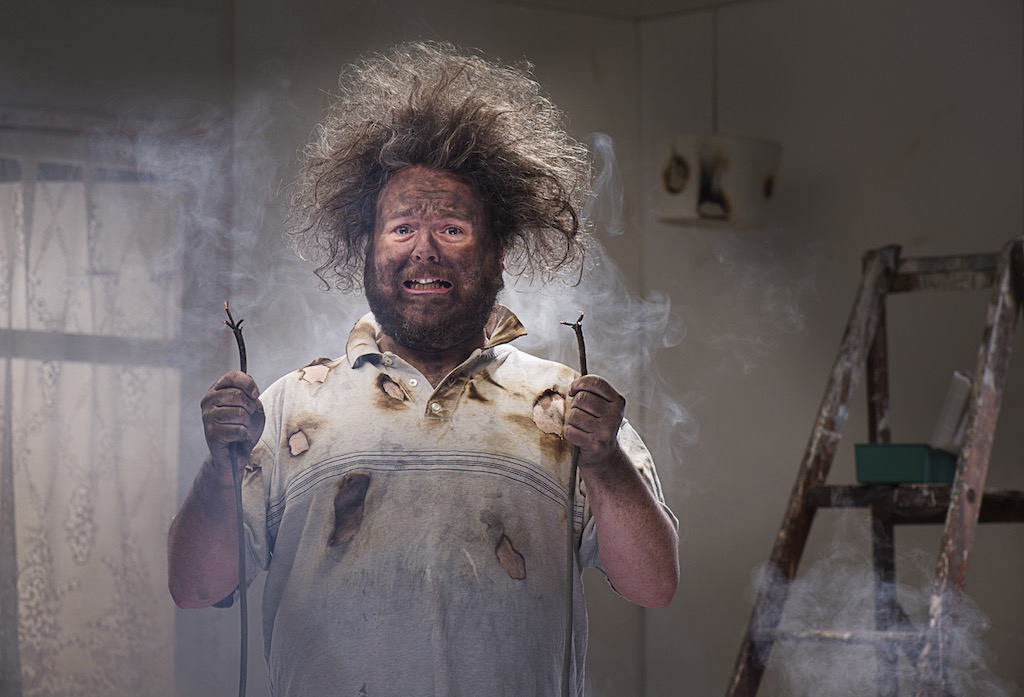Don’t let electrical wiring problems catch you in the dark—look for these signs of bad wiring & seek professional help.
When dealing with wiring for residential electric, Anderson homeowners need to take heed—never tamper with the wiring in your home. Only a licensed professional should do the work. When it’s working, the wiring in your home is invisible. But when wiring starts to go bad, problems can go unseen. To the untrained eye, good wiring often looks the same as bad wiring. But according to the U. S. Fire Administration, bad wiring causes more than $800 million in damages, more than 67,000 fires, and hundreds of deaths each year.
One problem is that many myths surround electrical wiring, and most homeowners are not qualified to fix their own electrical wiring problems. Yet try they will—the Do It Yourself industry is thriving. And while many homeowners can afford to try to fix a plumbing problem or put up drywall, they simply cannot afford to fix an electrical wiring problem, no matter how minor it may seem.
You can avoid serious injury and a major disaster by following these tips about common electrical wiring problems and their warning signs:
- Most modern homes are built with modern circuit breakers that have replaced the old-fashioned fuse box. It’s common for a circuit breaker to trip and turn off a circuit automatically. When this happens, you merely have to put the switch back. But if a circuit breaker trips frequently, you may be overloading and exceeding its safety capacity. It could also be a sign of a short somewhere in your wiring. Unrepaired, this problem could lead to a dangerous fire.
- Frequently flickering or dimming lights are a common problem in older homes, especially those equipped with modern appliances such as microwave ovens and desktop computers. Sometimes a flickering lamp itself is the problem—you should test the lamp or fixture in question in an outlet far from its normal one. But if more than one light or fixture flickers regularly, you could have a serious wiring problem. Consult a qualified electrician to determine if your household electrical system needs an upgrade.
- In the vast majority of cases, a modern circuit breaker is designed to hold a 15-amp breaker for maximum protection in most rooms. However, many homeowners replace those original 15-amp breakers with 20-amp breakers. This can be a fatal mistake because 20-amp breakers are meant for major appliances, not everyday use. Putting on the wrong breaker allows overloads to occur without tripping the breaker, increasing the risk of serious overheating and possibly a fire.
- Modern electrical appliances and light fixtures are designed to work without a hint that they need electricity to work. If your lamp buzzes when you turn it on, it could be because of a bad lamp or a bad wire. If you feel a slight shock, vibration, or buzz when you turn on an appliance, it could have a serious electrical problem. If a light fixture or appliance buzzes or shocks in another outlet, you need to have an electrician check out the wiring in your house.
- Electrical outlets should never be hot to the touch, never buzz, and never have char marks. These are warning signs of bad wiring inside or near the outlet. Another sign of bad wiring is a dead outlet. This problem could be caused by a loose wire or a faulty do-it-yourself job. Always have a licensed electrician perform even minor electrical repairs.
- Since electricity was first included in home construction, building codes have required that all home and commercial wiring must be done by a qualified and licensed electrician. When your home was built, all of the electrical outlets had to be grounded according to code. But over time, those ground wires can come loose. Or if one outlet is ungrounded for repairs, other outlets in the system become ungrounded as well.
- Ground fault circuit interrupters (GFCIs) are required by code anywhere an electrical current comes in contact with the ground or is placed near running water. These devices save lives by preventing the potential for deadly shocks. Modern GFCIs have built-in testers and should be tested regularly. If one of yours is not working properly, it could be the result of a faulty GFCI. But more seriously, it could be the result of faulty wiring.
- Faulty cable splices, damaged or frayed wires, or cut insulation can be an extreme fire hazard and are often a sign of an amateur electrical job. A problem like this one often goes unnoticed. If any wiring work was ever done in your home by an unlicensed electrician, you should have that work reviewed and corrected by a properly certified professional.
- Once popular in the 1960s and 1970s, aluminum wiring can be a major problem. Unlike traditional and more-effective copper wiring, aluminum wiring expands and contracts as the seasonal temperature changes, leading to loose connections and a major fire hazard. If your home has aluminum wiring, consider replacing it. If that job is too costly, at least have all the connections pigtailed with copper wiring.
- The odor of burning plastic or vinyl is unmistakable. But in the case of wiring, it may be hard to locate and identify. But if you smell something electrical burning, consider yourself lucky—most warning signs of electrical fires are invisible, colorless, and odorless. Electrical wiring can heat up and “burn” for years before it becomes superheated and ignited nearby materials.
If you’ve noticed any of these electric wiring problems in your home and need help correcting them, just give us a call . We specialize in residential electric in The Northern Twin Cities area and would love to help!



